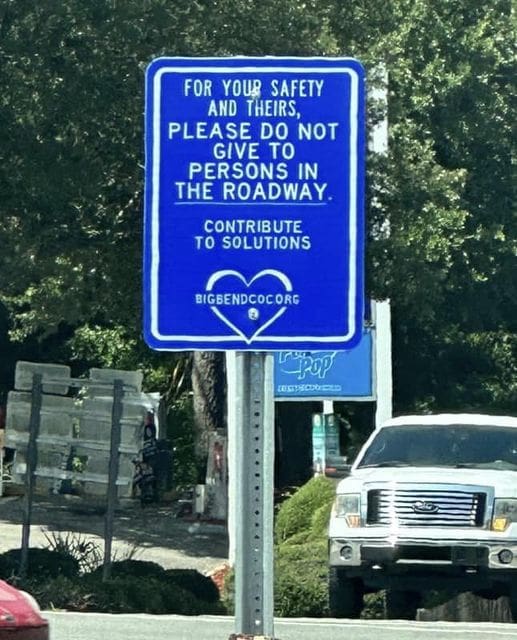The blue signs at 11 Leon County intersections have sparked a lot of talk. They urge the public to donate to service providers like the nonprofit Big Bend Continuum of Care, rather than giving directly to people panhandling on the street. But the need for solutions is growing faster than the response.
Taylor Biro serves on the board of directors of Big Bend Continuum of Care. Having been homeless herself in her teens, she went on to spend 10 years working street outreach in Tallahassee to connect people with housing. She recalls doing a survey with an older man to see if they could get him on their waiting list.
“He was very embarrassed,” she said. “He was an older gentleman and said he had built an entire construction company from the ground up, that he was successful, he was proud of it. He had no wife, he had no kids, he had never created a family. And he had gotten in a car accident, broke his back, and lost everything. Absolutely everything. And he said he was too old and too tired to start over. And so, he was just going to go in the woods.”
Last year, more than half a million people experienced homelessness across the United States. Tallahassee’s numbers more than doubled, says Johnna Coleman of Big Bend Continuum of Care. Here she’s addressing the Leon County Commission’s workshop on homelessness in May:
“Some of the increases are really linked to the decrease in Covid dollars,” she said. “Those dollars ended in 2022, as well as the ending of the eviction moratorium. And then we have also seen increases in eviction rates due to raises in rental costs and then the lack of affordable housing units available.”
The blue signs popping up now were part of a package commissioners adopted back in May. Commissioner Brian Welch, who posted a photo of one of the signs on social media, is pushing back against the criticism they’ve generated.
“You can still give food and water and money to people in an intersection, but we want you to know that the experts who deal with this issue every day are telling us that is not the most productive way to solve this problem,” Welch said. “You are in fact hurting those people in many cases more than you are helping them.”
Florida is the third highest state for numbers of unhoused people, according to Legal Services of North Florida, with just under 26,000 as of April. The majority of those people don’t go to shelters. Here’s Biro:
“During the pandemic I met a man who didn’t go in because he had an autoimmune issue and didn’t feel safe going in with 300 people,” she said. “So, there’s a number of reasons why someone wouldn’t go in. Women tend to not go in because it’s unsafe. Youth don’t go in because they’re more likely to be trafficked.”
Commissioner David O’Keefe says the commission was briefed that panhandlers on county roads mostly have homes or are transient, here for a few days. So, he reached out to Legal Services of North Florida, since some of their clients have such issues.
“Those folks who have a home who panhandle…Panhandlers on average make $300 a month,” O’Keefe said. “If they no longer can do so, they likely would become homeless, exacerbating the problem. And so, these signs were only one item of ten recommendations we got –some of which are great, that include increased funding and increased day programs to help people get off the street…”
Biro sees the wider community as being evenly divided about the blue signs.
“But with the service providers, because they get funding from the CoC and funding from the city and county, they’re very quiet during this time, because they…you know, they can’t speak out if this is evidence-based or not, which we know it’s not an evidence-based practice,” Biro said. “So, the public being vocal was not a surprise to me. Nor was the fact that the service providers are pretty quiet right now.”
O’Keefe predicts that following the blue signs, unhoused people will face higher hurdles in Leon County.
“Two of the other objectionable items that came among some very good items at the workshop are going to come back in the future that are worse, that do possibly hurt homeless people and make it more difficult for them to get off the streets in a more significant way,” he said. “And that’s soliciting in the medians, which will come back for a vote. And a program for the county to relocate people who are camping in public places to somewhere else.”
Legal Services of North Florida maintains that, quote, “expanding anti-panhandling laws will increase the rate of homelessness and will increase Criminal Justice System costs.”
9(MDA4MzU1MzUzMDEzMTkyMzAwMzY5MjY1Mw004))
9(MDA4MzU1MzUzMDEzMTkyMzAwMzY5MjY1Mw004))


